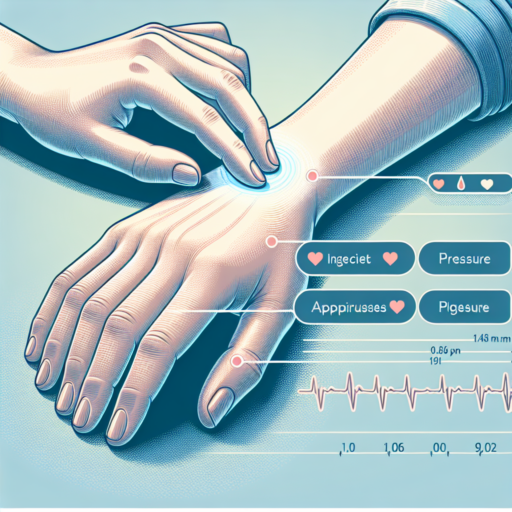No se han encontrado productos.
What should your wrist pulse be?
Understanding your wrist pulse is essential for monitoring your overall heart health. The normal range for an adult’s resting heart rate, felt at the wrist, is typically between 60 and 100 beats per minute (bpm). However, many factors can influence this number, including age, fitness level, and health status.
For athletes or those who are highly active, the wrist pulse may be lower than the average range, often seen as an indicator of an efficient and strong heart muscle. It’s not uncommon for athletes to have resting pulse rates below 60 bpm. On the contrary, a wrist pulse over 100 bpm in a resting state, known as tachycardia, may indicate underlying health issues or elevated stress levels.
To accurately measure your wrist pulse, it’s advised to do so in a calm state, preferably after sitting quietly for at least 5 minutes. Position your index and middle fingers on the inside of your wrist, just beneath the base of your thumb. Press lightly until you feel your pulse, counting the beats for 30 seconds and then doubling the count to obtain your pulse in beats per minute. Consistently high or low readings should prompt a consultation with healthcare professionals to rule out any health concerns.
Can you feel your heartbeat in your wrist?
Feeling your heartbeat in your wrist is a common experience for many people. This sensation, often described as a pulse, is the result of blood being pumped by the heart through the arteries. The area on your wrist where you can typically feel this rhythmic pulse is called the radial artery. This straightforward method is frequently used by individuals and healthcare professionals alike to check a person’s heart rate quickly.
How to Locate Your Pulse
Finding the heartbeat in your wrist is a simple process that anyone can learn. To locate your pulse, place your index and middle fingers together on the inside of the opposite wrist, slightly below the base of the thumb. Applying gentle pressure should allow you to feel the pulsing sensation of your heartbeat. This technique is often employed in various settings, from checking personal fitness levels to professional healthcare assessments.
Understanding Your Heart Rate
The rate at which you can feel your heartbeat through your wrist offers valuable insights into your cardiovascular health. A normal resting heart rate for adults ranges between 60 to 100 beats per minute. Factors such as fitness levels, age, medication, and stress can influence this rate. Recognizing what’s normal for you can help you monitor changes in your health and potentially indicate when to seek medical advice.
What is the proper way to check your heart rate?
Checking your heart rate is a simple yet essential procedure to monitor your cardiovascular health. It’s vital to know the correct technique to ensure the accuracy of the results. The process can be done manually or with the aid of digital devices.
Manual Method
To manually check your heart rate, locate your pulse either on your wrist or side of your neck. Use the tips of your first two fingers, not the thumb which has its own pulse. Once you find your pulse, count the number of beats in 60 seconds for an accurate measure or count for 30 seconds and multiply by two. Ensure your fingers are pressing lightly, as pressing too hard can alter the reading.
Using Digital Devices
For those preferring technology, digital devices like fitness trackers and smartwatches offer an easier way to monitor your heart rate. These devices continuously track your heart rate, providing data on your resting heart rate and during various levels of activity. Ensure the device’s sensor is in direct contact with your skin for accurate reading.
Understanding how to check your heart rate correctly can play a critical role in managing your overall health. Whether you choose the manual method or a digital device, consistency in method and timing are key for accurate monitoring and comparison over time.
What should a radial pulse be?
Understanding the characteristics of a radial pulse is essential for not only healthcare professionals but also for individuals looking to keep tabs on their heart health. The radial pulse, found on the wrist where the radial artery is closest to the skin, presents valuable insights into the cardiac rhythm and blood flow through the arteries.
Normal Radial Pulse Rate
The normal range of a radial pulse falls between 60 and 100 beats per minute (bpm) for an average adult at rest. It’s important to note that factors like physical activity, emotional states, and overall health can influence pulse rate. A pulse rate below 60 bpm could be considered bradycardia, indicating a slower-than-normal heartbeat. In contrast, a pulse over 100 bpm at rest might suggest tachycardia, pointing toward a faster-than-normal heartbeat.
How to Accurately Measure Your Radial Pulse
To measure the radial pulse, one should use the pads of the index and middle fingers, placing them gently yet firmly on the wrist at the base of the thumb. Applying light pressure should allow for the pulsations to be felt, thereby counting the number of beats in 60 seconds for an accurate measure. This process can help in detecting any irregularities or deviations from normal pulse rates, assisting in early detection of potential health issues.




